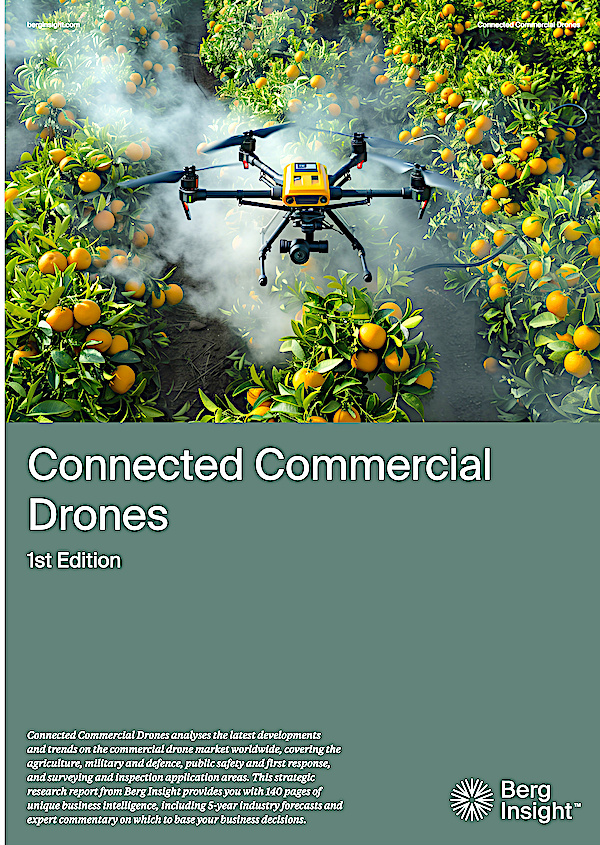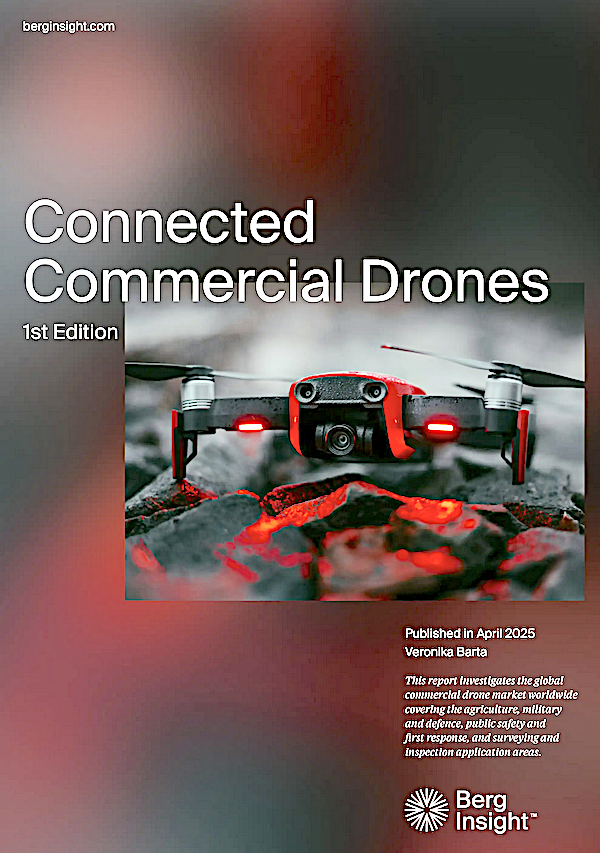

Berg Insight, an IoT market research provider, today released a new report covering connected commercial drones used for industrial and governmental purposes. The global market for connected commercial drones is forecasted to grow from US$ 18.6 billion in 2024 at a compound annual growth rate (CAGR) of 15 percent to reach US$ 37.3 billion in 2029. The market value includes drone systems and associated software used for applications within agriculture, military and defence, public safety and first response, surveying and inspection, as well as other areas such as delivery and logistics. The forecast excludes drones used for recreational purposes, drones offered as services as well as weaponised military-grade drones. The most prominent application area for connected drones is the military and defence sector, accounting for about 60 percent of the total market value in 2024.
Commercial drones have high payload capacities, long flight times and robust navigation systems. These drones also incorporate advanced ground control stations and communications systems to support their operation, enabling them to be used in several industries. The top players active in the commercial drone space range from specialised technology suppliers of varying sizes to leading drone manufacturers. Many of the key players today serve several application areas, while other solution providers may focus on one single use case. The market is led by China-based DJI, which has an estimated 70 percent market share of the global drone market as of 2024. Other leading drone manufacturers include Autel Robotics and JOUAV based in China, France-based Delair and Parrot, and Skydio, AeroVironment and AgEagle from the US. The commercial drone market is set for a consolidation journey in the upcoming years as many application areas are fragmented. The solution providers are also largely impacted by the developing regulations, which can affect the adoption of commercial drones worldwide.

Besides all drones featuring RF communications as default for both flight control and data transmission, it is common that commercial drones also feature cellular or satellite connectivity when long-distance missions are to be conducted. “Reliable communications systems are especially important for BVLOS (beyond visual line of sight) operations”, says Veronika Barta, IoT Analyst at Berg Insight. Losing connectivity during flight can lead to safety and operational issues such as the drone abandoning the mission. “As regulations for BVLOS flights progress, wireless technologies need to ensure that the drone can always communicate with ground control stations even at long distances”, continues Ms. Barta. Cellular 4G/5G provides reliable support for two-way data transfer between the control station and supporting platforms such as unmanned traffic management systems. Another option is to combine cellular and satellite technologies, ensuring that drones can maintain real-time connectivity with their control stations over long distances and in challenging environments. “The flexibility to switch between cellular and satellite networks can optimise performance across diverse environments, making drone missions more resilient”, concluded Ms. Barta.
Download report brochure: Connected Commercial Drones
Berg Insight is a dedicated M2M/IoT market research firm based in Sweden. We have been specialising in all major M2M/IoT verticals such as fleet management, car telematics, smart metering, smart homes, mHealth and industrial M2M since 2004. Our vision is to be the most valuable source of intelligence for our customers. Berg Insight offers numerous market reports, detailed market forecast databases and advisory services. We provide custom research tailored to your requirements including focussed research papers, business case analysis, go-to-market strategies and bespoke market forecasting. We have provided analytical services to 1500 clients in 72 countries on six continents to date. Our customers range from many of the world’s largest mobile operators, IT companies and telecom vendors, to venture capitalists, technology start-ups and specialist consultants.
